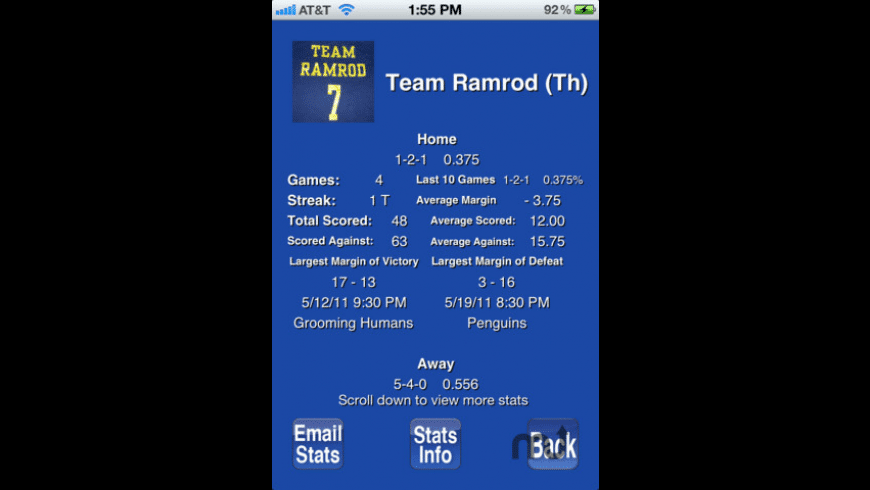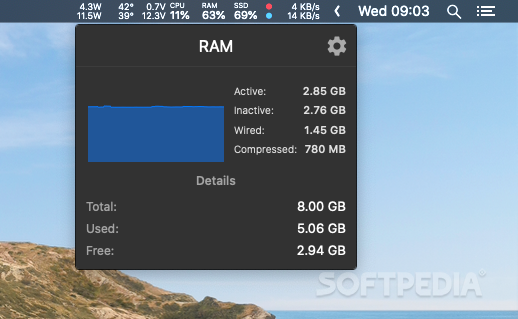But what if you work for a math-heavy industry, pharmacology, medicine or sociology, and complex statistical analysis is part of your daily routine? Did you find a user-friendly data analysis tool that works on your Mac?
IBM SPSS Statistics is the most widely used statistical analysis software in corporate environment and SPSS for Mac covers the entire analytical process. This includes everything from planning and data collection to reporting and deployment. Stata will run on the listed platforms. While Stata software is platform-specific, your Stata license is not; therefore, you need not specify your operating system when placing your order for a license. PAST: absurdly wide-ranging, free Mac statistics software. Current Version: 3.26 / requires OS 10.8-10.15 (PAST 3.18 reviewed) Listing updated: 12/2017 (program updated August 2019) Not signed by Apple (warning box presented when you first load the software). STANDARDS The stat and fstat function calls are expected to conform to IEEE Std 1003.1-1988 (``POSIX.1'). HISTORY An lstat function call appeared in 4.2BSD. The stat64, fstat64, and lstat64 system calls first appeared in Mac OS X 10.5 (Leopard). 4th Berkeley Distribution April 19, 1994 4th Berkeley Distribution.
StatPlus:mac turns your copy of Microsoft Excel for Mac (2004 - 2019) or Apple Numbers into a powerful statistical tool without making you learn another software or part with extraordinary amounts of money. You'll use the familiar interface to perform complex analysis and calculations, enabling you to concentrate on analyzing the results rather than figuring out how to achieve them.
Upgrade Your Spreadsheet
Turn Microsoft Excel or Apple Numbers into a powerful statistical package with StatPlus:mac and perform data analysis on a Mac in the familiar environment. Stop wasting your time learning new tools and try StatPlus:mac right away.
70+ Features
StatPlus:mac allows Mac users to perform all forms of data analysis from the very basics to complex analysis, including non-parametric and regression analysis, survival and time series analysis, and a wide variety of other methods. Version 7 includes standalone spreadsheet and can be used without Microsoft Excel or Apple Numbers installed.
Multi-platform
StatPlus:mac is available for both Mac and PC platforms (PC version includes standalone and Excel add-in versions) at no extra charge. Save learning time and costs for your mixed PC and Mac environment.

Free Trial
We have free trial that gives you an opportunity to evaluate the software before you purchase it. Should you have any questions during the trial period, please feel free to contact our Support Team.
Affordable
StatPlus:mac is most affordable solution for data analysis on Mac (with Excel and Numbers support). You will benefit from the reduced learning curve and attractive pricing while enjoying the benefits of precise routines and calculations. Mac/PC license is permanent, there is no renewal charges.
Requirements
Ph Stat For Mac
StatPlus:mac requires macOS 10.9-10.15 (macOS Catalina is supported; v5 requires 10.5+). StatPlus:mac supports Microsoft Excel for Mac (supported versions: 2004, 2008, 2011, 2016, 2019) and Apple Numbers v3/v4/v5 as a data source. StatPlus:mac does not require Internet connection (except for optional auto-update feature).
Statistical features list
- Pro Features
- Standalone spreadsheet with Excel (XLS and XLSX), OpenOffice/LibreOffce Calc (ODS) and text documents support.
- 'Add-in' mode for Excel 2004, 2008, 2011, 2016 and 2019.
- 'Add-in' mode for Apple Numbers v3, v4 and v5.
- Priority support.
- Permanent license and free major upgrades during the maintenance period.
- Access to Windows version.
- Options to emulate Excel Analysis ToolPak results and migration guide for users switching from Analysis ToolPak.
- Basic Statistics
- Detailed descriptive statistics.
- One-sample t-test.
- Two-sample t-test.
- Two-sample t-test for summarized data.
- Fisher F-test.
- One-sample and two-sample z-tests.
- Correlation analysis and covariance.
- Normality tests (Jarque-Bera, Shapiro-Wilk, Shapiro-Francia, Cramer-von Mises, Anderson-Darling, Kolmogorov-Smirnov, D'Agostino's tests).
- Cross-tabulation and Chi-square.
- Frequency tables analysis (for discrete and continuous variables).
- Multiple definitions for computing quantile statistics.
- Analysis of Variance (ANOVA)
- One-way and two-way ANOVA (with and without replications).
- Three-way analysis of variance.
- Post-hoc comparisons - Bonferroni, Tukey-Kramer, Tukey B, Tukey HSD, Neuman-Keuls, Dunnett.
- General Linear Models (GLM) ANOVA.
- Within subjects ANOVA and mixed models.
- Multivariate Analysis
- Principal component analysis (PCA).
- Factor analysis (FA).
- Discriminant function analysis.
- Nonparametric Statistics
- 2x2 tables analysis (Chi-square, Yates Chi-square, Exact Fisher Test, etc.).
- Rank and percentile.
- Chi-square test.
- Rank correlations (Kendall Tau, Spearman R, Gamma, Fechner).
- Comparing independent samples
Mann-Whitney U Test, Kolmogorov-Smirnov test, Wald-Wolfowitz Runs Test, Rosenbaum Criterion. Kruskal-Wallis ANOVA and Median test. - Comparing dependent samples
Wilcoxon Matched Pairs Test, Sign Test, Friedman ANOVA, Kendall's W (coefficient of concordance). - Cochran's Q Test.
- Regression Analysis
- Multivariate linear regression (residuals analysis, collinearity diagnostics, confidence and prediction bands).
- Weighted least squares (WLS) regression.
- Logistic regression.
- Stepwise (forward and backward) regression.
- Polynomial regression.
- Curve fitting.
- Tests for heteroscedasticity: Breusch–Pagan test (BPG), Harvey test, Glejser test, Engle's ARCH test (Lagrange multiplier) and White test.
- Time Series Analysis
- Data processing.
- Fourier analysis.
- Smoothing.
- Moving average.
- Analysis.
- Autocorrelation (ACF and PACF).
- Interrupted time series analysis.
- Unit root tests - Dickey–Fuller, Augmented Dickey–Fuller (ADF test), Phillips–Perron (PP test), Kwiatkowski–Phillips–Schmidt–Shin (KPSS test).
- Survival Analysis
- Life tables.
- Kaplan-Meier (log rank test, hazard ratios).
- Cox proportional-hazards regression.
- Probit-analysis (Finney and LPM).
LD values (LD50/ED50 and others), cumulative coefficient calculation. - Receiver operating characteristic curves analysis (ROC analysis).
AUC methods - DeLong's, Hanley and McNeil's. Report includes: AUC (with confidence intervals), curve coordinates, performance indicators - sensitivity and specificity (with confidence intervals), accuracy, positive and negative predictive values, Youden's J (Youden's index), Precision-Recall plot. - Comparing ROC curves.
- Data Processing
- Sampling (random, periodic, conditional).
- Random numbers generation.
- Standardization.
- Stack/unstack operations.
- Matrix operations.
- Statistical Charts
- Histogram
- Scatterplot.
- Box plot.
- Stem-and-leaf plot.
- Bland-Altman plot.
- Bland-Altman plot with multiple measurements per subject.
- Quantile-quantile Q-Q plots for different distributions.
- Control charts - X-bar, R-chart, S-chart, IMR-chart, P-chart, C-chart, U-chart, CUSUM-chart.
There are times we need to do some repetitive tasks in the process of data preparation, analysis or presentation, for instance, computing a set of variables in a same manner, rename or create a series of variables, or repetitively recode values of a number of variables. In this post, I show a few of simple example “loops” using Stata commands -foreach-, -local- and -forvalues- to handle some common simple repetitive tasks.
-foreach-: loop over items

Consider this sample dataset of monthly average temperature for three years.
Now the mean temperatures of each month are in Centigrade, if we want to convert them to Fahrenheit, we could do the computation for the 12 variables.
However this takes a lot of typing. Alternatively, we can use the -foreach- command to achieve the same goal. In the following codes, we tell Stata to do the same thing (the computation: c*9/5+32) for each of the variable in the varlist – mtemp1 to mtemp12.
Note that braces must be specified with -foreach-. The open brace has to be on the same line as the foreach, and the close brace must be on a line by itself. It’s crucial to close loops properly, especially if you have one or more loops nested in another loop.

-local-: define macro
This was a rather simple repetitive task which can be handled solely by the foreach command. Here we introduce another command -local-, which is utilized a lot with commands like foreach to deal with repetitive tasks that are more complex. The -local- command is a way of defining macro in Stata. A Stata macro can contain multiple elements; it has a name and contents. Consider the following two examples:
Define a local macro called mcode and another called month, alter the contents of mcode in the foreach loop, then display them in a form of “mcode: month”.
Note when you call a defined macro, it has to be wrapped in “`” (left tick) and “‘” (apostrophe) symbols.
Rename multiple variables
Take the temperature dataset we created as an example. Let’s say we want to rename variables mtemp1-mtemp12 as mtempjan-mtenpdec. We can do so by just tweaking a bit of the codes in the previous example.
Define local macro mcode and month, then rename the 12 vars in the foreach loop.
We can obtain the same results in a slightly different way. This time we use another 12 variables fmtemp1-fmtemp12 as examples. Again, we will rename them as fmtempjan-fmtempdec.
Define local macro month, then define local macro monthII in the foreach loop with specifying the string function word to reference the contents of the local macro month.
Mac Stat Iupui
I usually run -display- to see how the macro looks like before actually applying the defined macro on tasks like changing variable names, just to make sure I don’t accidentally change them to some undesired results or even cause errors; however the display line is not necessary in this case.
Windirstat For Mac
Here we rename them back to fmtemp1-fmtemp12.
-forvalues-: loop over consecutive values
The -forvalues- command is another command that gets to be used a lot in handling repetitive works. Consider the same temperature dataset we created, suppose we would like to generate twelve dummy variables (warm1-warm12) to reflect if each of the monthly average temperature is higher than the one in the previous year. For example, I will code warm1 for the year of 2014 as 1 if the value of fmtemp1 for 2014 is higher than the value for 2013. I will code all the warm variables as 99 for the year of 2013, since they don’t have references to compare in this case.
We can do this by running the following codes, then repeat them for twelve times to create the twelve variables warm1-warm12.
However this takes a lot of typing and may even create unwanted mistakes in the process of typing or copy-paste them over and over.
Instead, we can use -forvalues- to do so:
Nba Sheldon Mac Stats
Reference
Baum, C. (2005). A little bit of Stata programming goes a long way… Working Papers in Economics, 69.
Stat Priority For Machinist
View the entire collection of UVA Library StatLab articles.
Yun Tai
CLIR Postdoctoral Fellow
University of Virginia Library
